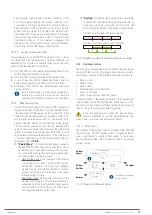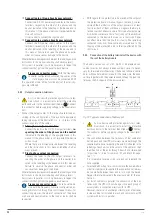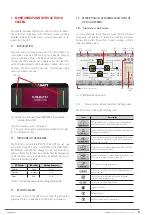
31
•
Danger of electric shock
. If after starting up the
UPS, it is necessary to disconnect the battery cab-
inet, it must carry out a complete stop of the device.
Open the battery fused isolator switch or the battery dis-
connect switch located on the accumulator cabinet and/or
the fused isolator switch or disconnect switch on the UPS.
Wait at least 5 minutes until the filter capacitors have been
discharged.
5.5.5. Earth terminal connection.
•
As it is a device with protection against class I elec-
trical shock, it is essential to install the protective
earth conductor to the terminal identified as
. Connect
this conductor before supplying voltage to the input termi-
nals.
•
Make sure that all loads connected to the UPS are only con-
nected to this ground terminal. Failure to limit the grounding
of the load or loads and the cabinet or battery cabinets to
this single point will create loops back to ground that will
degrade the quality of the power supplied.
5.5.6. Parallel connection.
When we talk about paralleling in this section we refer to UPS,
since the paralleling of modules is a characteristic of the entire
SLC ADAPT2 series.
The following table specifies the number of UPS cabinets in
parallel according to their configuration.
UPS configuration
Maximum
cabinets
in parallel
Maximum
modules in
parallel
3x400 V
2 slots with 10 kVA modules (20 kVA)
9
18
2 slots with 15 kVA modules (30 kVA)
9
18
4 slots with 10 kVA modules (40 kVA)
7
28
3 slots with 15 kVA modules (45 kVA)
7
21
6 slots with 10 kVA modules (60 kVA)
5
30
6 slots with 15 kVA modules (90 kVA)
5
30
3x208 V /
3x220 V
2 slots with 6 kVA modules (12 kVA)
9
18
2 slots with 9 kVA modules (18 kVA)
9
18
4 slots with 6 kVA modules (24 kVA)
7
28
3 slots with 9 kVA modules (27 kVA)
7
21
6 slots with 6 kVA modules (36 kVA)
5
30
6 slots with 9 kVA modules (54 kVA)
5
30
Table 4.
Number of UPS cabinets in parallel according to
their configuration.
5.5.6.1. Parallel bus connection.
•
The COM communications line constitutes a very
low voltage safety circuit.
To preserve the quality, it must be installed separately from
other lines carrying dangerous voltages (power distribution
line).
Parallel connection bus
UPS no. 1
•••
•••
SW2
P1
P2
SW1
UPS No. 'N'
SW2
P1
P2
SW1
OFF
ON
OFF
ON
Fig. 25.
DB15 connectors on the communication bus.
•
Parallel connection bus
. Use the 15-wire signal hose with
mesh and DB15 connectors at the ends to attach a maximum
of 5 sub-racks with the sequence shown in
. Each hose has
a male and a female connector at the ends, which must be
connected between two correlative devices. It is imperative
to close the bus loop in parallel.
The length of the parallel cable is about 1.5 meters and
should not be prolonged under any circumstances due to
the risk of interferences and failures in the communication
that this would entail.
shows an installation with two devices in parallel. For five
units, proceed similarly to close the communications bus.
•
Parallel bus settings
. Although up to nine devices can
be connected in parallel, it is necessary to change the posi-
tion of the Mini DIP Switches SW1 and SW2 located on
the back of the device, depending on the number of UPSs
in parallel.
The device is shipped from the factory adjusted to the re-
quested requirements. When it is necessary to modify the
initial configuration of the number of units, the position of
SW1 and/or SW2 must be changed according to
and each
device must be configured using the software application.
These actions are exclusively reserved for the
T.S.S.
or the
distributor.
UPSs in
parallel
SW1
SW2
1
ON
ON
2
ON
OFF
3
OFF
OFF
4
OFF
OFF
5
OFF
OFF
6
OFF
OFF
7
OFF
OFF
8
OFF
OFF
9
OFF
OFF
Table 5.
SW1 and SW2 settings for paralleled units.
To access them it is necessary to remove the corresponding
cover that keeps them from tampering and then reinsert it.
Input circuit breaker
Output circuit breaker
Manual bypass
UPS no. 1
UPS No. 'N'
Input
To loads
•••
SLC ADAPT 2
- UNINTERRUPTIBLE POWER SUPPLY SYSTEM
-
USER MANUAL
















































